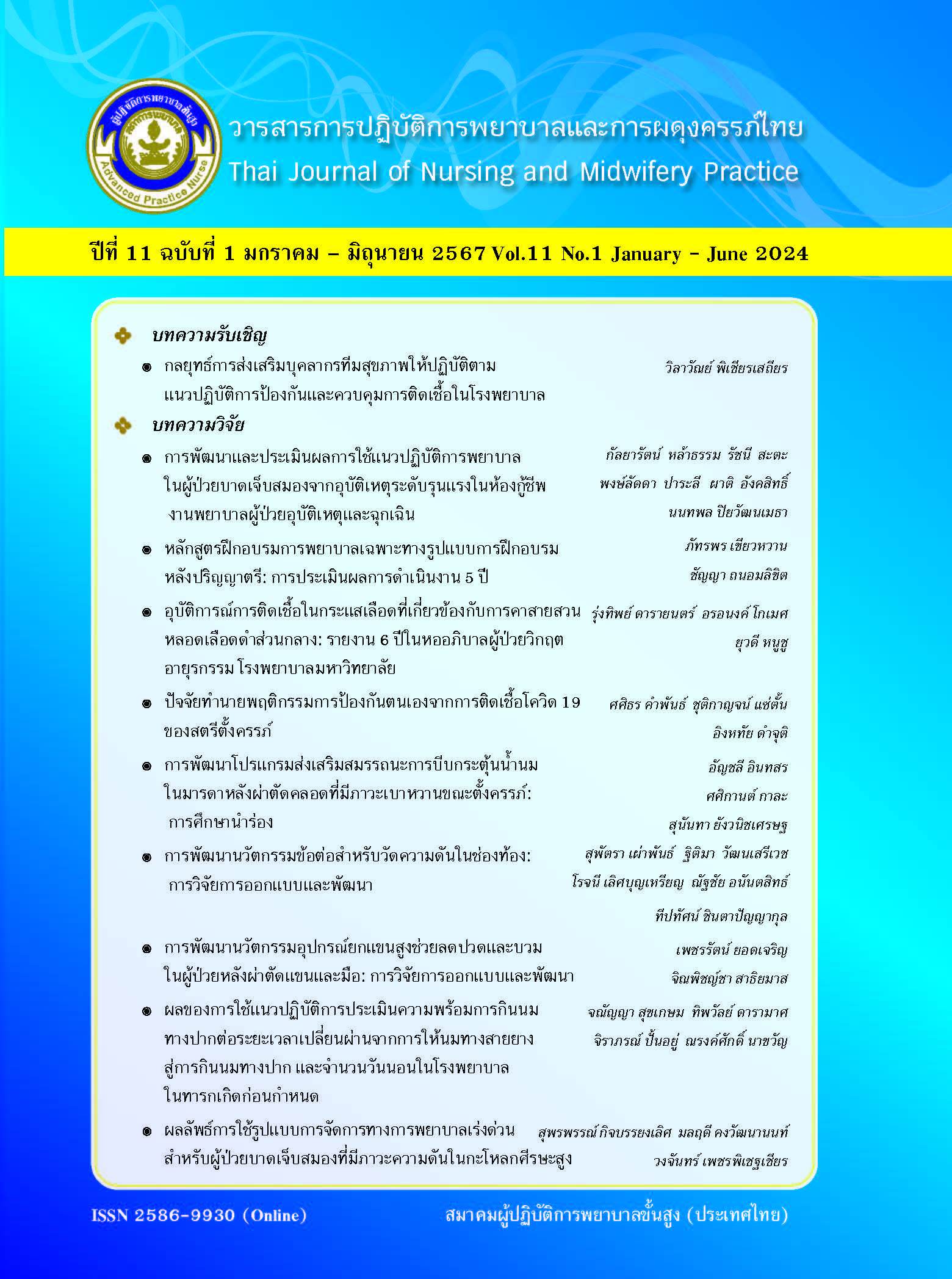การพัฒนาและประเมินผลการใช้แนวปฏิบัติการพยาบาลในผู้ป่วยบาดเจ็บสมองจากอุบัติเหตุระดับรุนแรงในห้องกู้ชีพงานพยาบาลผู้ป่วยอุบัติเหตุและฉุกเฉิน
Main Article Content
บทคัดย่อ
บทคัดย่อ: การวิจัยและการพัฒนานี้ มีวัตถุประสงค์เพื่อ 1) พัฒนาแนวปฏิบัติการพยาบาลเพื่อป้องกันภาวะพร่องออกซิจนและภาวะความดันในกะโหลกศีรษะสูง 2) ประเมินความเป็นไปได้ของการใช้แนวปฏิบัติการพยาบาลและความพึงพอใจของพยาบาล 3) ประเมินผลลัพธ์ผู้ป่วย โดยใช้กรอบแนวคิดหลักฐานเชิงประจักษ์ของชูคัพ เป็นแนวทางในการศึกษา กลุ่มตัวอย่าง คือ พยาบาล 37 คน และผู้ป่วยบาดเจ็บสมองจากอุบัติเหตุระดับรุนแรง 63 คน เครื่องมือวิจัยคือ แนวปฏิบัติการพยาบาล แบบบันทึกข้อมูลทั่วไป แบบบันทึกผลลัพธ์ผู้ป่วยบาดเจ็บ แบบสอบถามความเป็น
ไปได้การนำใช้และแบบประเมินความพึงพอใจ วิเคราะห์ข้อมูลโดยใช้สถิติเชิงพรรณนาและสถิติที่คู่ ผลพบว่า แนวปฏิบัติการพยาบาลเพื่อป้องกันภาวะพร่องออกซิเจนและภาวะความดันในกะโหลกศีรษะสูง พัฒนาจากหลักฐานเชิงประจักษ์ 14 เรื่อง ประกอบด้วย 4 หมวด คือ 1) การดูแลเครื่องช่วยหายใจ 2) การดูแลจัดท่าผู้ป่วย 3) การดูแลทงเดินหายใจ และ4) การเฝ้าระวัง เมื่อประเมินผลหลังใช้แนวปฏิบัติในการดูแลผู้ป่วยกับพยาบาล พบว่า แนวปฏิบัตินี้มีความเป็นไปได้ในการนำไปใช้อยู่ในระดับมาก (M = 2.9, SD = 0.3) และพยาบาลมีความพึงพอใจในระดับมากที่สุด
(M = 4.7, SD = 0.5) ผลลัพธ์ด้านผู้ป่วย พบว่า ค่าเฉลี่ยออกซิเจนที่ปลายนิ้ว และค่าความเข้มข้นของคาร์บอนไดออกไซค์ในลมหายใจออกสุด ก่อนจำหน่ายสูงกว่าเมื่อแรกรับอย่างมีนัยสำคัญทางสถิติ (P < .05) ส่วนค่าเฉลี่ยระดับความรู้สึกตัวและค่ความดันโลหิตแรกรับและก่อนจำหน่าย พบว่าไม่แตกต่างกัน ดังนั้น ควรนำแนวปฏิบัติการพยาบาลนี้ไปใช้ในผู้ป่วยบาดเจ็บสมองจากอุบัติเหตุระดับรุนแรงในห้องกู้ชีพ เพื่อป้องกันภาวะพร่องออกชิเจนและความดันในกะโหลกศีรษะสูง
Downloads
Article Details

This work is licensed under a Creative Commons Attribution-NonCommercial-NoDerivatives 4.0 International License.
References
Sripontan J. Development of a care map for head injured patients by evidence-based practice in emergency department at Mahasarakham Hospital. Mahasarakham Hosp J. 2010; 7(2): 10-7. Thai.
Tantivisut S, Namvongprom A, Sirikul S. Effectiveness of nursing system development in using evidence-based protocol on quality of care in patients with severe traumatic brain injury. Journal of Nursing and Therapeutic Care. 2011; 29(3): 5-14. Thai.
Accident and Emergency Unit, Nursing Service Division, Srinagarind Hospital. Accident and Emergency Outpatient Unit Statistics A.D. 2018-2020. Khon Kaen: Srinagarind Hospital; 2020. Thai.
Cowley NJ, da Silva EJ. Prevention of secondary brain injury following head trauma. Trauma. 2008; 10(1): 35-42. doi: 10.1177/1460408608
McNett M, Doheny M, Sedlak CA, et al. Judgments of critical care nurses about risk for secondary brain injury. Am J Crit Care. 2010; 19(3): 250-60. doi: 10.4037/ajcc2009293.
Potaya S. Prevention and risk reduction of secondary brain injury. EAU Heritage J Sci Technol. 2019; 13(3): 22-31. Thai.
Haddad SH, Arabi YM. Critical care management of severe traumatic brain injury in adults. Scand J Trauma Resusc Emerg Med. 2012; 20(12): 1-15. doi: 10.1186/1757-7241-20-12.
Carney N, Totten AM, O’Reilly C, et al. Guidelines for the management of severe traumatic brain injury, fourth edition. Neurosurgery. 2017; 80(1): 6-15. doi: 10.1227/NEU.0000000000001432.
Kitkhuandee A, Tiamkao S, Sumanont S, et al. Clinical practice guideline of traumatic brain injury for medical personnel (CPG TBI) second edition 2013: Successful head injury fast track (SHIFT). Khon Kaen: National Health Security Office Khon Kean Branch (Region 7); 2013. Thai.
Teeratakulpisarn P. Initial assessment and management in trauma patient. In: Thanapaisal C, Wongkonkitsin N, Techaatik P, Sumritrin S, editors. Trauma life support in emergency room. Khon Kaen: Faculty of Medicine, Khon Kaen University; 2019. p. 17-36. Thai.
Norasan S. Head injuries. In: Saimai P, Norasan S, editors. Trauma nursing. Bangkok: Faculty of Medicine Ramathibodi Hospital, Mahidol University; 2016. p. 101–32. Thai.
Techaatik P, Wunsupong S, Sumritrin S. Effectiveness of implementing evidence-based practice for traumatic patients at the Out Patient of Accident and Emergency Unit. Khon Kaen: Accident and Emergency Unit, Nursing Service Division, Srinagarind Hospital; 2012. Thai.
Damkliang J, Considine J, Kent B, et al. Initial emergency nursing management of patients with severe traumatic brain injury: Development of an evidence-based care bundle for the Thai emergency department context. Australas Emerg Nurs J. 2014; 17(4): 152-60. doi: 10.1016/j.aenj.2014.05.005.
Damkliang J, Considine J, Kent B, et al. Using an evidence-based care bundle to improve Thai emergency nurses’ knowledge of care for patients with severe traumatic brain injury. Nurse Educ Pract. 2015; 15(4): 284-92. doi: 10.1016/j.nepr.2015.03.007.
Soukup SM. The Center for Advanced Nursing Practice evidence-based practice model: promoting the scholarship of practice. Nurs Clin North Am. 2000; 35(2): 301-9.
Diloksakulchai F. Evidence-based nursing principle and method. 4th ed. Bangkok: Faculty of Nursing, Mahidol University; 2008. Thai.
Chow SC, Shao J, Wang H, editors. Sample size calculations in clinical research. New York: Marcel Dekker; 2003.
Thamcharoentraku B, Saensom D. Supra-cuff Suctioning: innovation for ventilator-associated pneumonia prevention Supra-cuff Suctioning: Innovation for ventilator-associated pneumonia prevention. JBCNM. 2018; 24(1): 130-42. Thai.
Best JW. Research in education. 3rd ed. Englewood Cliffs (NJ): Prentice-Hall; 1977.
Phunawakul S, Reungsri S, Montarak O, et al. The development of clinical nursing practice guideline for patients with surgery from traumatic brain injury in Phichit hospital. J DMS. 2017; 42(6): 102-7. Thai.
Pumipichet A. Mechanical ventilation management in the emergency room. In: Permpikul C, Chakorn T, editors. First hour in emergency room: The practical approach. 2012. Bangkok: Department of Emergency Medicine, Faculty of Medicine Siriraj Hospital,
Mahidol University; 2012. p. 112-31. Thai.
Hanmanop P, Sriraksa A. Effects of suctioning apply program on oxygen saturation and vital signs post brain surgery in head injury patients with mechanical ventilator. Journal of Nurses’ Association of Thailand, North-Eastern Division. 2012; 30(2): 106-13. Thai.
Pedersen CM, Rosendahl-Nielsen M, Hjermind J, et al. Endotracheal suctioning of the adult intubated patient-what is the evidence? Intensive Crit Care Nurse. 2009; 25(1): 21-30.
Dumrongjitti P, Srisanit R, Duangdee P. Development of nursing practice guidelines for major trauma patients in Chaophya Abhaibhubejhr hospital. J Public Health Nurse. 2014; 28(1): 43-54. Thai.

